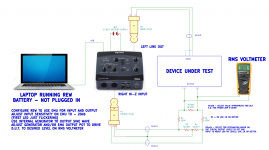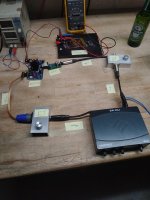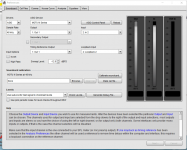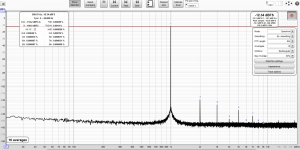The Behringer does not have galvanic isolated usb port and not true differential I/O either. So, if connected to a desktop and/or run interconnects from the DUT both for in and out with ground connection, then ground loops might occur.
I assume gnd-loops are not the actual issue.The Behringer does not have galvanic isolated usb port and not true differential I/O either. So, if connected to a desktop and/or run interconnects from the DUT both for in and out with ground connection, then ground loops might occur.
The EMU has bal input but SE-output. On the pcb I discovered additional op-amps delivering the balanced signal. So I connected the left channel to an additional TRS jack for a fully balanced signal chain.The Behringer does not have galvanic isolated usb port and not true differential I/O either. So, if connected to a desktop and/or run interconnects from the DUT both for in and out with ground connection, then ground loops might occur.
Also what i guessed about the input/output !The Behringer does not have galvanic isolated usb port and not true differential I/O either. So, if connected to a desktop and/or run interconnects from the DUT both for in and out with ground connection, then ground loops might occur.
Do you recall, how excatly you connect your's ? - Cablesize / quality, lenght, XLR connection on pin 1,2 & 3, TR orTRS plug on output 😊
Jesper.
XLR pin1=- pin2=+ pin3=gndAlso what i guessed about the input/output !
Do you recall, how excatly you connect your's ? - Cablesize / quality, lenght, XLR connection on pin 1,2 & 3, TR orTRS plug on output 😊
Jesper.
As I said, I've modified mine to bypass front panel connectors and installed TRS on the rear. XLR only make sense for balanced mic otherwise use standard TRS. For loop measurements of the soundcard I don't recall any issues using an ordinary interconnect from input to output. But for measuring amps I always used it together with Pete Millett's interface which provides isolation.
Connection from soundcard out to amp in is via shielded cable and a passive attenuator (10k poti). Balanced or unbalanced. And this is the route for the one and only GND connection between both. The return path is balanced - you will need this anyway measuring bridge output of class d-amps. There is another attenuator in between. This cable is shielded as well, but shield is connected exclusively to soundcard gnd to break any gnd loop. In case of a single ended tube output the input- is tied to amp gnd, input+ to amp out hot.As I said, I've modified mine to bypass front panel connectors and installed TRS on the rear. XLR only make sense for balanced mic otherwise use standard TRS. For loop measurements of the soundcard I don't recall any issues using an ordinary interconnect from input to output. But for measuring amps I always used it together with Pete Millett's interface which provides isolation.
I just remembered that another member had posted a complete schematic of this soundcard's analog stages in the thread I mentioned earlier. Perhaps it would be helpful to follow ground paths. FWIW, I modified it taking inputs directly to the ADC buffer.
https://www.diyaudio.com/community/threads/behringer-umc-202hd-for-measurements.341309/post-6741244
https://www.diyaudio.com/community/threads/behringer-umc-202hd-for-measurements.341309/post-6741244
Connection from soundcard out to amp in is via shielded cable and a passive attenuator (10k poti). Balanced or unbalanced. And this is the route for the one and only GND connection between both. The return path is balanced - you will need this anyway measuring bridge output of class d-amps. There is another attenuator in between. This cable is shielded as well, but shield is connected exclusively to soundcard gnd to break any gnd loop. In case of a single ended tube output the input- is tied to amp gnd, input+ to amp out hot.
Hi hey...
Are you ref. to this EMU setup which was posted in this thread regarding the GND connection to the soundcard ?
Jesper.
Attachments
That is in fact identical, except the unbalanced output wiring.Hi hey...
Are you ref. to this EMU setup which was posted in this thread regarding the GND connection to the soundcard ?
Jesper.
The test setup looks like thisThat is in fact identical, except the unbalanced output wiring.
Attachments
Thank's a lot for all your'e help guy's...The test setup looks like this
Really appreciate it 👍
I'am modifying the Behringer right now, for the direct-IN mod, which MagicBus did on the other thread.
Will post my findings there i guess. MagicBus's thread
Jesper.
Just remember not to overdrive those cmos opamps on board! Happy to answer any questions on the other thread.
Hi folks, having bought all the gear last year I still have no idea but do have a new laptop so am trying to get this setup working again but will need handholding through this. My audio interface is a Motu M2. I would like to first of all set it up to do a loopback? to measure its own distortion?
So in preferences what do I choose and what do i connect together on the Motu?
So in preferences what do I choose and what do i connect together on the Motu?
Attachments
I think he might be referring to this post: https://www.diyaudio.com/community/...ion-measurements-with-rew.338511/post-6353901Hi hey...
Are you ref. to this EMU setup which was posted in this thread regarding the GND connection to the soundcard ?
Jesper.
I used the differential inputs and outputs to get slightly better results from the EMU 0404 USB.
Hi folks, having bought all the gear last year I still have no idea but do have a new laptop so am trying to get this setup working again but will need handholding through this. My audio interface is a Motu M2. I would like to first of all set it up to do a loopback? to measure its own distortion?
So in preferences what do I choose and what do i connect together on the Motu?
Ok, figured the loopback test out, results look good?
Attachments
They do. Your THD+N results are better than mine are🙂Ok, figured the loopback test out, results look good?
Looking at the specs of the Motu I would expect even better performance. Keep in mind that the sweetspots of THD+N are found on higher levels than for THD. And these are separate for audio in and audio out. Line-In is the best input available for measurements. I would be quite interested in the final sweet spots of your Motu.
I do you mean better loopback performance? If so what settings would you use in rew?Looking at the specs of the Motu I would expect even better performance. Keep in mind that the sweetspots of THD+N are found on higher levels than for THD. And these are separate for audio in and audio out. Line-In is the best input available for measurements. I would be quite interested in the final sweet spots of your Motu.
Yes, loopback performance first. You may vary digital output level somewhere between -10 ~ -1dB FS for best THD+N.
- Home
- Design & Build
- Software Tools
- How to - Distortion Measurements with REW



